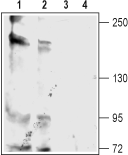Overview
- Peptide (C)KDVKDPGHHRSIHR, corresponding to amino acid residues 991-1004 of rat Slick (Accession Q6UVM4). Intracellular, C-terminus.
- Rat and mouse brain samples (1:200).
 Western blot analysis of rat (lanes 1 and 3) and mouse (lanes 2 and 4) brain membranes:1,2. Anti-KCNT2 (Slick) Antibody (#APC-126), (1:200).
Western blot analysis of rat (lanes 1 and 3) and mouse (lanes 2 and 4) brain membranes:1,2. Anti-KCNT2 (Slick) Antibody (#APC-126), (1:200).
3,4. Anti-KCNT2 (Slick) Antibody, preincubated with KCNT2/Slick Blocking Peptide (#BLP-PC126).
- Rat olfactory bulbs primary cultures. (Li, P. et al. (2017) eNeuro 4, e0114-17.2017.).
KCa4.1 (Na+-activated K+ channel, Slack, Slo2.2, KCNT1) was originally cloned and named so due to its high similarity to the Slo genes1. Shortly after its discovery, KCa4.2 (Slick, Slo2.1, KCNT2), its sister channel, was also cloned2. Although KCa4.2 (like KCa4.1) is functionally a Na+-activated K+ channel (KNa), it is termed KCa by the IUPHAR nomenclature, due to its sequence homology to other KCa channels. Both channels are activated by high intracellular concentrations of Na+.
Like Slack, Slick contains six transmembrane spanning domains, a P-region between transmembrane regions 5 and 6 and intracellular N- and C-termini. However, the N-terminal domain of Slick is significantly shorter than that of Slack. In addition, contrary to Slack, Slick is regulated by ATP as it has an ATP binding site in its C-terminal domain2. ATP binding reduces the activity of the channel and mutations of this site abolish the inhibitory effect2. Both channels are regulated by intracellular Cl- ions, but Slick displays higher sensitivity3. Also, the overall electrical characteristics of Slick channels are different from those of Slack; Slick is rapidly activated in response to depolarization, and also has a basal level of activity in the absence of Na+.
Both channels are highly expressed in the brain with overlapping expression. Slick is found in the midbrain, brainstem, and hippocampus and throughout the neocortex. This KNa channel is also detected in the auditory neurons in the brainstem. Detection of Slick was also found in the heart, although at much lower levels2.
Many different functions have been attributed to KNa channels including action potential repolarization, slow after-hyperpolarization, burst firing and adaptation after repetitive firing3. These channels also contribute to the response of neurons to hypoxia.
Application key:
Species reactivity key:
 Expression of Slick (Slo2.1) channel in rat olfactory bulb.Immunocytochemical staining of dissociated rat olfactory bulbs primary cultures using Anti-KCNT2 (Slick) Antibody (#APC-126). A. Slick staining (green). B. GABA(B) R1 receptor staining (red). C. Merged image.Adapted from Li, P. et al. (2017) eNeuro 4, e0114-17.2017. with permission of the Society for Neuroscience.
Expression of Slick (Slo2.1) channel in rat olfactory bulb.Immunocytochemical staining of dissociated rat olfactory bulbs primary cultures using Anti-KCNT2 (Slick) Antibody (#APC-126). A. Slick staining (green). B. GABA(B) R1 receptor staining (red). C. Merged image.Adapted from Li, P. et al. (2017) eNeuro 4, e0114-17.2017. with permission of the Society for Neuroscience.
